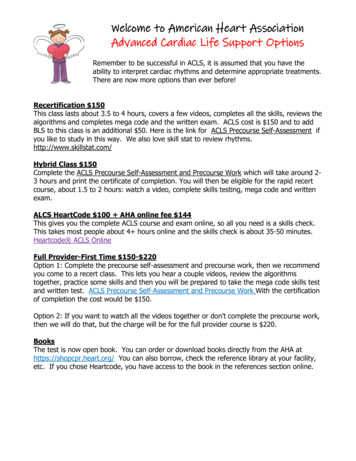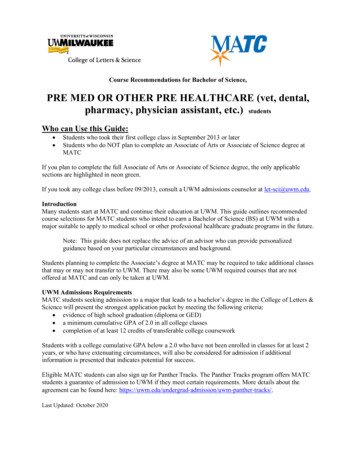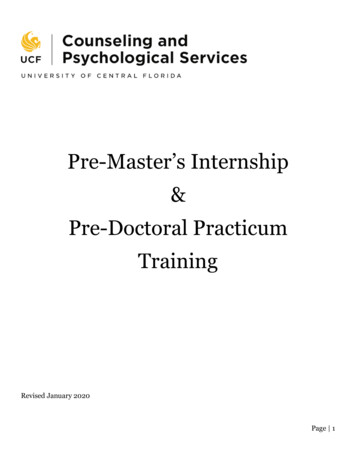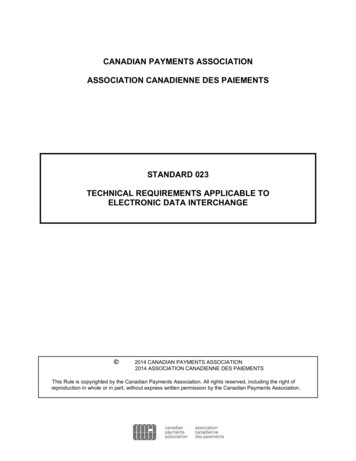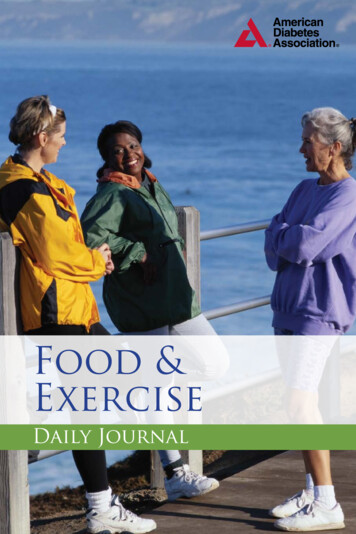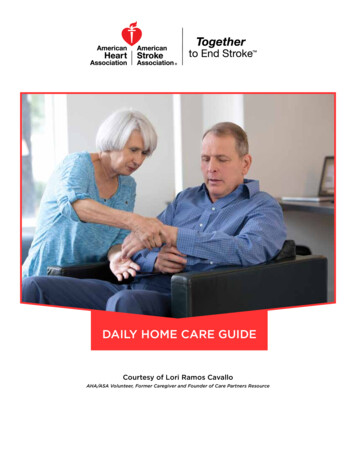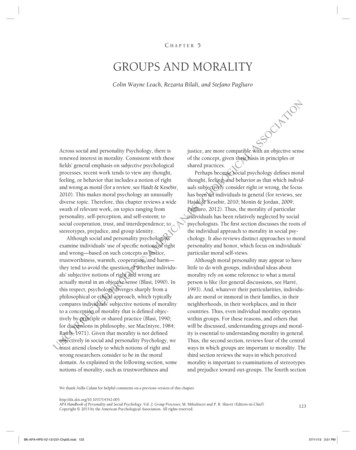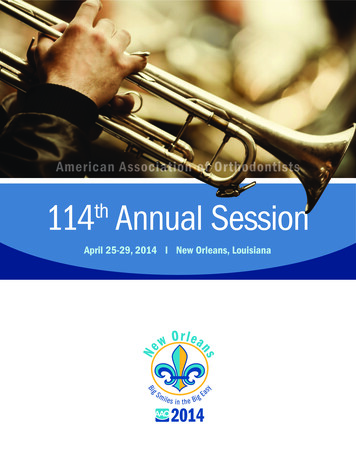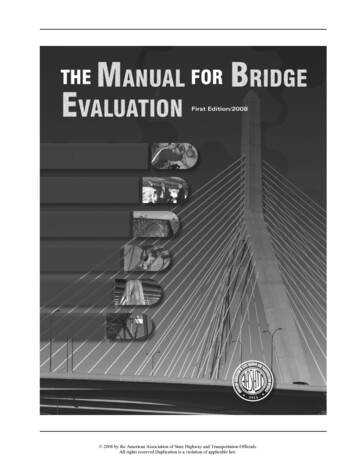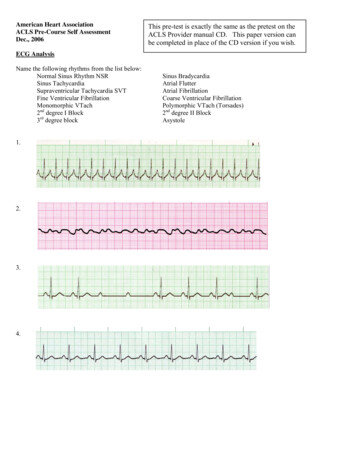
Transcription
American Heart AssociationACLS Pre-Course Self AssessmentDec., 2006This pre-test is exactly the same as the pretest on theACLS Provider manual CD. This paper version canbe completed in place of the CD version if you wish.ECG AnalysisName the following rhythms from the list below:Normal Sinus Rhythm NSRSinus TachycardiaSupraventricular Tachycardia SVTFine Ventricular FibrillationMonomorphic VTach2nd degree I Block3rd degree block1.2.3.4.Sinus BradycardiaAtrial FlutterAtrial FibrillationCoarse Ventricular FibrillationPolymorphic VTach (Torsades)2nd degree II BlockAsystole
Name the following rhythms from the list below:Normal Sinus Rhythm NSRSinus TachycardiaSupraventricular Tachycardia SVTFine Ventricular FibrillationMonomorphic VTach2nd degree I Block3rd degree block5.6.7.8.9.Sinus BradycardiaAtrial FlutterAtrial FibrillationCoarse Ventricular FibrillationPolymorphic VTach (Tordsades)2nd degree II BlockAsystole
Name the following rhythms from the list below:Normal Sinus Rhythm NSRSinus TachycardiaSupraventricular Tachycardia SVTFine Ventricular FibrillationMonomorphic VTach2nd degree I Block3rd degree block10.11.12.13.14.Sinus BradycardiaAtrial FlutterAtrial FibrillationCoarse Ventricular FibrillationPolymorphic VTach (Torsades)2nd degree II BlockAsystole
Name the following rhythms from the list below:Normal Sinus Rhythm NSRSinus TachycardiaSupraventricular Tachycardia SVTFine Ventricular FibrillationMonomorphic VTach2nd degree I Block3rd degree block15.16.17.18.19.20.Sinus BradycardiaAtrial FlutterAtrial FibrillationCoarse Ventricular FibrillationPolymorphic VTach (Torsades)2nd degree II BlockAsystole
Pharmacology21.Which of the following is most accurate regarding the administration of vasopressin during cardiac arrest?a.b.c.d.22.Your patient has been intubated. IV/IO access is not available. Which combination of drugs can beadministered by the endotracheal route of administration?a.b.c.d.23.Give an additional 2 mg of morphine sulfateStart dopamine at 2 ụg/kg per minute and titrate to BP 100 systolic.Give nitroglycerin 0.4 mg sublinguallyGive normal saline 250 mL to 500 mL fluid bolusA patient has a rapid irregular wide-complex tachycardia. The ventricular rate is 138. He is asymptomaticwith a BP of 110/7-. He has a history of angina. Which of the following actions is recommended?a.b.c.d.26.Magnesium is indicated for VF/pulseless VT associated with torsades de pointesMagnesium is indicated for shock-refractory monomorphic VTMagnesium is contraindicated in VT associated with a normal QT intervalMagnesium is indicated for VF refractory to shock and amiodarone or lidocaine.A patient with a possible acute coronary syndrome has ongoing chest discomfort unresponsive to 3sublingual nitroglycerine tablets. There are no contraindications and 4 mg of morphine sulfate wasadministered. Shortly, BP falls to 88/60 and the patient complains of increased chest discomfort. Youwould:a.b.c.d.25.Amiodarone, lidocaine, epinephrineEpinephrine, vasopressin, amiodaroneLidocaine, epinephrine, vasopressinVasopressin, amiodarone, lidocaineWhich of the following statements about the use of magnesium in cardiac arrest is most accurate?a.b.c.d.24.Vasopressin is indicated for VF and pulseless VT prior to the delivery of the first shockThe correct dose of Vasopressin is 40 U administered IV or IOVasopressin is recommended instead of epinephrine for the treatment of asystoleVasopressin can be administered twice during cardiac arrestGive lidocaine 1-1.5 mg IV bolusImmediate synchronized cardioversionSeek expert consultationGive adenosine 6 mg IV bolusA 62 year-old man suddenly began to experience difficulty speaking and left-sided weakness. He isbrought to the ER. He meets initial criteria for fibrinolytic therapy and a CT scan of the brain is ordered.Guidelines for antiplatelet and antothrombotic therapy are:a.b.c.d.Administer heparin if CT scan is negative for hemorrhageGive aspirin 160 mg and clopidogrel 75 mg orallyAdminister aspirin 160-325 mg orally chewed, immediatelyDo not give aspirin for at least 24 hours if tPA is administered
27.A patient is in cardiac arrest. VFib has been refractory to an initial shock. Two attempts at peripheral IVhave been unsuccessful. The next recommended access route of administration for the delivery of drugsduring CPR is:a.b.c.d.28.A patient with an ST-segment elevation MI has ongoing chest discomfort. Fibrinolytic therapy has beenordered. Heparin 4000 U IV bolus was administered and a heparin infusion 100 U per hour is beingadministered, and Aspirin was not taken by the patient because he had a history of gastritis treated 5 yearsago. Your next action is to:a.b.c.d.29.Atropine 1 mgEpinephrine 1 mgVasopressin 20 USodium bicarbonate 50 mEqA 35-year old woman has palpitations, lightheadedness, and a stable tachycardia. The monitor shows aregular narrow-complex QRS at a rate of 180/min. Vagal maneuvers have not been effective in terminatingthe rhythm. An IV has been established. What drug should be administered IV?a.b.c.d.32.Atropine 0.5 mgAtropine 1.0 mgAtropine 0.1 mgAtropine 3 mgA patient is in cardiac arrest. VFib has been refractory to an initial shock. Of the following, which drugand dose should be administered first by IV/IO route?a.b.c.d.31.Substitute clopidogrel 300 mg loading doseGive aspirin 160 – 325 mg chewed, immediatelyGive 75 mg enteric-coated aspirin onlyGive 325 mg enteric-coated aspiring rectallyA patient with possible ACS and a bradycardia of 42/min has ongoing chest discomfort. What is the initialdose of atropine?a.b.c.d.30.External jugular veinFemoral veinIntraosseousEndotrachealEpinephrine 2-10 ụg/kg per minuteAtropine 0.5 mgLidocaine 1 mg/kgAdenosine 6 mgA patient with a possible ST-segment elevation MI has ongoing chest discomfort. Which of the followingwould be a contraindication for administration of nitrates?a.b.c.d.HR of 90/minBP 180 systolicUse of phosphodiesterase inhibitor within 12 hoursLeft ventricular infarct with bilateral rales
33.A patient has sinus bradycardia with a rate of 36/min. Atropine has been administered to a total dose of 3mg. TCP has failed to capture. The patient is confused and BP is 100/60. Which of the following is nowindicated?a.b.c.d.34.A patient is in pulseless VTach. Two shocks and one dose of epinephrine have been given. The nextdrug/dose to anticipate to administer is:a.b.c.d.e.35.place a Combitube or Laryngeal Mask Airway (LMA)Attempt intubation with minimal CPR interruptionCall for a pulse checkPlace IV or IO accessWhich of the following is most accurate regarding the administration of vasopressin during cardiac arrest?a.b.c.d.38.0.5-0.75 mg/kg IV push2-3 mg/kg IV pushGive endotracheal dose 2-4 mg/kgStart infusion 1-2 mg/min1 mg/kg IV pushYou arrive on-scene with the Code Team. High-quality CPR is in progress. An AED has previouslyadvised “no shock indicated”. A rhythm now finds asystole. The next action you would take is to:a.b.c.d.37.Vasopressin 40UAmiodarone 150 mgLidocaine 0.5 mg/kgEpinephrine 3 mgAmiodarone 300 mgA patient is in refractory VFib and has received multiple appropriate defibrillations, epinephrine 1 mg IVtwice, and an initial dose of lidocaine IV. The patient is intubated. A second dose of lidocaine is nowcalled for. The recommended second dose of lidocaine is:a.b.c.d.e.36.give additional 1mg AtropineGive NS bolus 250 mL-500mLStart dopamine 10-20 ụg/kg per minuteStart epinephrine 2-10 ụg/minVasopressin is indicated for VF and pulseless VT prior to the delivery of the first shockVasopressin can be administered twice during cardiac arrestVasopressin is recommended instead of epinephrine for the treatment of asystoleThe correct dose of Vasopressin is 40 U administered IV or IOA patient is in cardiac arrest. High-quality chest compression are being given. The patient is intubated andan IV has been established. The rhythm is asystole. The first drug/dose to administer is:a.b.c.d.e.Atropine 0.5 mg IV or IOEpinephrine 3 mg via ETTDopamine 2 to 20 ụg/kg per minute IV or IOAtropine 1 mg IV or IOEpinephrine 1 mg or Vasopressin 40 U IV or IO
39.A 57 year-old woman has palpitations, chest discomfort and tachycardia. The monitor shows a regularwide-complex QRS at a rate of 180.min. She becomes diaphoretic and BP is 80/60. The next action is to:a.b.c.d.40.A patient is in refractory VFib. High quality CPR is in progress and shocks have been given. One dose ofepinephrine was given after the second shock. An antiarrhythmia drug was given immediately after thethird shock. What drug should the team leader request to be prepared for administration?a.b.c.d.41.Obtain 12 lead ECGPerform immediate synchronized cardioversionEstablish IV and give sedation for electrical cardioversionGive amiodarone 300 mg IV pushRepeat the antiarrhythmicEscalating dose epinephrine 3 mgSecond dose of epinephrine 1 mgSodium bicarbonate 50 mEqA bradycardia rhythm IS treated when:a.b.c.d.HR is 60 with or without symptomsBP 100 systolic with out without symptomsThe patient has an MI on the 12-lead ECGCP or shortness of breath is presentPractical Application42.You arrive on the scene to find CPR in progress. Nursing staff report that the patient was recovering from apulmonary embolism and suddenly collapsed. There is no pulse or spontaneous respirations. High-quality CPRis in progress and effective ventilation is being provided with bag-mask. An IV has been initiated. You wouldnow:a.b.c.d.e.order immediate endotracheal intubationgive epinephrine 1.0 mg IVgive atropine 1 mg IVgive atropine 0.5 mg IVinitiate transcutaneous pacing
43You are monitoring this patient after successful resuscitation. You note the above rhythm on the cardiacmonitor and document a rhythm strip for the patient’s chart. She has no complaints and blood pressure is110/70 mm Hg. Now you would:a.b.c.d.e.prepare for transcutaneous pacing (place pacing pads, do not pace yet)give atropine 0.5 mg IVstart dopamine 2 to 10 ụg/kg per minute and titrate heart rategive atropine 1 mg IVadminister sedation and begin immediate transcutaneous pacing at 80 beats/min44.Following initiation of CPR and one shock for VF, this rhythm is present on the next rhythm check. A secondshock is given and chest compressions are immediately resumed. An IV is in place and no drugs have beengiven. Bag-mask ventilations are producing visible chest rise. What is your next order?a.b.c.d.e.administer 3 sequential (stacked) shocks at 200J (biphasic defibrillator)administer 3 sequential (stacked) shocks at 360J (monophasic defibrillator)prepare to give amiodarone 300 mg IVprepare to give epinephrine 1 mg IVperform endotracheal intubation; administer 100 % oxygen45.You are evaluating a patient with a 15-minute duration of chest pain during transportation to the emergencydepartment. He is receiving oxygen, and 2 sublingual nitroglycerin tablets have relieved his chest discomfort.He has no complaints but appears anxious. BP is 130/70 mm Hg. You observe the above rhythm on themonitor and your next action is:a.b.c.d.e.start epinephrine 2 to 10 ụg/kg per minute and titrateadminister nitroglycerine 0.4 mg SLcontinue monitoring patient, prepare for TCPinitiate transcutaneous pacing (TCP)give atropine 0.5 mg IV
46You arrive on-scene and find a 56 year-old diabetic woman complaining of chest discomfort. She is pale anddiaphoretic, complaining of lightheadedness. Her BP is 80/60 mm Hg. The cardiac monitor documents therhythm above. She is receiving oxygen at 4 L/min by Nasal Cannula, and an IV has been established.Transcutaneous Pacing has been requested but is not yet available. Your next order is:a.b.c.d.e.start dopamine 2 to 10 ụg/kg per minutegive morphine sulfate 4 mg IVgive atropine 1 mg IVgive nitroglycerine 0.4 mg SLgive atropine 0.5 mg IV47.The patient was admitted to the general medical unit with a history of alcoholism. A is in progress and he hasrecurrent episodes of this rhythm. You review his chart. Notes about the 12-lead ECG say that his baselineQT-interval is top normal to slightly prolonged. He has received 2 doses of epinephrine 1 mg and 1 dose ofamiodarone 300 mg IV so far. For his next medication you would now order:a.b.c.d.e.give sodium bicarb 50 mEq IVgive magnesium sulfate 1 to 2 g IV diluted in 10 mL D5W given over 10 -20 mins.repeat amiodarone 300 mg IVrepeat amiodarone 150 mg IVlidocaine 1 to 1.5 mg IV and start infusion 2 mg/minute
48A patient becomes unresponsive and you are uncertain if a faint pulse is present with the above rhythm. Yournext action is:a.b.c.d.e.consider causes for pulseless electrical activity.Start an IV and give atropine 1 mgStart an IV and give epinephrine 1 mg IVOrder transcutaneous pacingBegin CPR with high-quality chest compressions49.You are monitoring a patient. Chest discomfort has been relieved with sublingual nitro and morphine sulfate 4mg IV. He suddenly has the above persistent rhythm. You ask about symptoms and he reports mildpalpitations, but otherwise he is clinically stable with unchanged vital signs. Your next action is:a.b.c.d.e.give immediate synchronized cardioversionadminister amiodarone 150 mg over 10 minutes; seek expert consultationgive sedation and perform synchronized cardioversiongive immediate unsynchronized defibrillation shockadminister magnesium sulfate 1 to 2 g IV diluted in 10 mL D5W over 5-20 minutes
50.A patient with an acute MI on a 12-lead ECG transmitted by the paramedics has the above findings on a rhythmstrip when a monitor is placed in the ED. The patient had resolution of moderate (5/10) chest pain with threedoses of sublingual nitroglycerine. BP is 104/70 mm Hg. Which intervention below is most important,reducing in-hospital and 30-day mortality?a.b.c.d.e.atropine 0.5 mg IV, total dose 2 mg as neededatropine 1 mg IV, total dose 3 mg as neededreperfusion therapyintravenous nitroglycerin for 24 hoursTemporary pacing51.You are the code team leader and arrive finding the above rhythm with CPR in progress. Team members reportthat th
ACLS Pre-Course Self Assessment Dec., 2006 ECG Analysis Name the following rhythms from the list below: Normal Sinus Rhythm NSR Sinus Bradycardia Sinus Tachycardia Atrial Flutter Supraventricular Tachycardia SVT Atrial Fibrillation Fine Ventricular Fibrillation Coarse Ventricular Fibrillation
